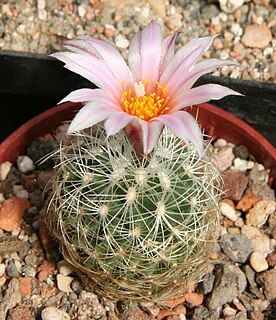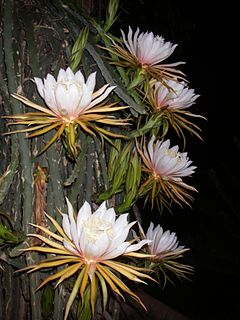Austrocylindropuntia is a genus of cacti (family Cactaceae) with 11 recognized species, which were once included in the genus Opuntia . Some are native to South America.
Austrocylindropuntia is a genus of cacti (family Cactaceae) with 11 recognized species, which were once included in the genus Opuntia . Some are native to South America.
| Image | Scientific name | Distribution |
|---|---|---|
 | Austrocylindropuntia cylindrica | Ecuador (Azuay, Bolivar, Canar, Carchi, Chimborazo, Cotopaxi, Imbabura, Napo, Pichincha, Sucumbios, Tungurahua) |
 | Austrocylindropuntia floccosa | Peru, Bolivia |
| Austrocylindropuntia hirschii | Peru | |
 | Austrocylindropuntia lagopus | Peru, Bolivia |
 | Austrocylindropuntia pachypus | Peru (Ancash, Lima) |
| Austrocylindropuntia punta-caillan | Peru (Ancash) | |
| Austrocylindropuntia shaferi | Argentina (Jujuy) | |
 | Austrocylindropuntia subulata | Peru (Cusco, Lima, Puno ) |
| Austrocylindropuntia verschaffeltii | Argentina (Catamarca, Jujuy, Salta), Bolivia (La Paz, Oruro, Potosi), Chile (Antofagasta ) | |
 | Austrocylindropuntia vestita | Argentina, Bolivia |

A cactus is a member of the plant family Cactaceae, a family comprising about 127 genera with some 1750 known species of the order Caryophyllales. The word cactus derives, through Latin, from the Ancient Greek word κάκτος (káktos), a name originally used by Theophrastus for a spiny plant whose identity is now not certain. Cacti occur in a wide range of shapes and sizes. Although some species live in quite humid environments, most cacti live in habitats subject to at least some drought. Many live in extremely dry environments, even being found in the Atacama Desert, one of the driest places on Earth. Because of this, cacti show many adaptations to conserve water. For example, almost all cacti are succulents, meaning they have thickened, fleshy parts adapted to store water. Unlike many other succulents, the stem is the only part of most cacti where this vital process takes place. Most species of cacti have lost true leaves, retaining only spines, which are highly modified leaves. As well as defending against herbivores, spines help prevent water loss by reducing air flow close to the cactus and providing some shade. In the absence of true leaves, cacti's enlarged stems carry out photosynthesis. Cacti are native to the Americas, ranging from Patagonia in the south to parts of western Canada in the north—except for Rhipsalis baccifera, which also grows in Africa and Sri Lanka.

Rebutia is a genus of flowering plants in the family Cactaceae, native to Bolivia and Argentina. They are generally small, colorful cacti, globular in form, which freely produce flowers that are relatively large in relation to the body. They have no distinctive ribs, but do have regularly arranged small tubercles. They are considered fairly easy to grow and they may produce large quantities of seeds that germinate freely around the parent plant.

Pereskia is a small genus of about four species of cacti that do not look much like other types of cacti, having substantial leaves and non-succulent stems. The genus is named after Nicolas-Claude Fabri de Peiresc, a 16th-century French botanist. The genus was more widely circumscribed until molecular phylogenetic studies showed that it was paraphyletic. The majority of species have since been transferred to Leuenbergeria and Rhodocactus. Although Pereskia does not resemble other cacti in its overall morphology, close examination shows spines developing from areoles, and the distinctive floral cup of the cactus family.

Epiphyllum is a genus of epiphytic plants in the cactus family (Cactaceae), native to Central America and South America. Common names for these species include climbing cacti, orchid cacti and leaf cacti, though the latter also refers to the genus Pereskia.

In 1984, the International Organization for Succulent Plant Study set up a working party, now called the International Cactaceae Systematics Group, to produce a consensus classification of the cactus family, down to the level of genus. Their classification has been used as the basis for systems published since the mid-1990s. Treatments in the 21st century have generally divided the family into around 125–130 genera and 1,400–1,500 species, which are then arranged in a number of tribes and subfamilies. However, subsequent molecular phylogenetic studies have shown that a very high proportion of the higher taxa are not monophyletic, i.e. they do not contain all of the descendants of a common ancestor. As of March 2017, the internal classification of the family Cactaceae remained uncertain and subject to change. A classification incorporating many of the insights from the molecular studies was produced by Nyffeler and Eggli in 2010.

Turbinicarpus is a genus of very small to medium-sized cacti, which inhabit the north-eastern regions of Mexico, in particular the states of San Luis Potosí, Guanajuato, Nuevo León, Querétaro, Hidalgo, Coahuila, Tamaulipas and Zacatecas.

Disocactus is a genus of epiphytic cacti in the tribe Hylocereeae found in Central America, the Caribbean and northern South America. It should not be confused with Discocactus, which is a different genus.

Hylocereus is a former genus of epiphytic cacti, often referred to as night-blooming cactus. Several species previously placed in the genus have large edible fruits, which are known as pitayas, pitahayas or dragonfruits. In 2017, a molecular phylogenetic study confirmed an earlier finding that the genus Hylocereus was nested within Selenicereus, so all the species of Hylocereus were transferred to Selenicereus.

Blossfeldia is a genus of cactus containing only one species, Blossfeldia liliputiana, native to South America in northwestern Argentina and southern Bolivia. It grows at 1,200–3,500 m altitude in the Andes, typically growing in rock crevices, and often close to waterfalls.

Rhipsalis is a genus of epiphytic flowering plants in the cactus family, typically known as mistletoe cacti. They are found in parts of Central America, the Caribbean and northern regions of South America. They also inhabit isolated locations in Africa and Asia, and are the only cactus group naturally occurring in the Old World. This is the largest and most widely distributed genus of epiphytic cacti.

Reicheocactus, is a monotypic genus of cactus in the family Cactaceae, native to north western Argentina. It has only one known species; Reicheocactus famatimensis(Speg.) Schlumpb.

Cylindropuntia is a genus of cacti, containing species commonly known as chollas, native to northern Mexico and the Southwestern United States. They are known for their barbed spines that tenaciously attach to skin, fur, and clothing. Stands of cholla are called cholla gardens. Individuals within these colonies often exhibit the same DNA, as they were formerly tubercles of an original plant.

Grusonia is a genus of opuntioid cacti, originating from the North American Deserts in Southwest United States and northern Mexico, including Baja California. Authors differ on precise boundaries of the genus, which has been included in Cylindropuntia. Corynopuntia, also known as club chollas, is now a synonym, with the genus originally being described by Knuth in 1935. Molecular phylogenetic studies suggest that it should be included in Grusonia, a view accepted by Plants of the World Online as of June 2021.

Joseph Nelson Rose was an American botanist. He was born in Union County, Indiana. His father died serving during the Civil War when Joseph Rose was a young boy. He later graduated from high school in Liberty, Indiana.

Cacteae is a tribe of plants of the family Cactaceae found mainly in North America especially Mexico. As of August 2018, the internal classification of the family Cactaceae remained uncertain and subject to change. A classification incorporating many of the insights from the molecular studies was produced by Nyffeler and Eggli in 2010.

Opuntioideae is a subfamily of the cactus family, Cactaceae. It contains 15 genera divided into five tribes. The subfamily encompasses roughly 220–250 species, and is geographically distributed throughout the New World from Canada, to Argentina. Members of this subfamily have diverse habits, including small geophytes, hemispherical cushions, shrubs, trees, and columnar cacti consisting of indeterminate branches or determinate terete or spherical segments.

Smicripidae is a family of beetles, in the superfamily Cucujoidea. The common name for this family is palmetto beetles. The family only has one extant genus, Smicrips, with six extant species native to tropical and subtropical regions of the Americas and extinct species from the Eocene of Europe and one extinct genus, Mesosmicrips, known from the mid Cretaceous aged Burmese amber. Smicrips larvae are usually found amongst decaying vegetation, while adults are typically found on infloresences, especially those of Arecaceae (palms), althought associations with flowers of Fabaceae (legumes), Passifloraceae, Bombacaceae and Cactaceae (cactus) have also been recorded. Their diet is unknown.
Many cacti are known to be psychoactive, containing phenethylamine alkaloids such as mescaline. However, the two main ritualistic (folkloric) genera are Echinopsis, of which the most psychoactive species is the San Pedro cactus, and Lophophora, with peyote being the most psychoactive species. Several other species pertaining to other genera are also psychoactive, though not always used with a ritualistic intent.

Austrocylindropuntia subulata is a species of cactus native to the Peruvian Andes. The Latin specific epithet subulata means "awl-like", referring to the shape of the rudimentary leaves. It is also known by its common names as Eve's pin and Eve's needle.

Austrocylindropuntia cylindrica, the cane cactus, is a species of flowering plant in the family Cactaceae. It is native to Colombia, Ecuador, and Peru, and it has been introduced to the Canary Islands, Morocco, Eritrea, Ethiopia, South Africa, Australia, and New Zealand. A popular ornamental, it is an invasive species in Europe, South Africa, and Australia. Due to a misidentification, for a time this species was erroneously thought to contain mescaline.